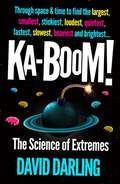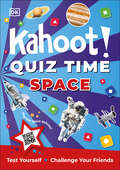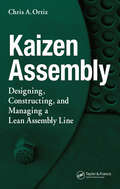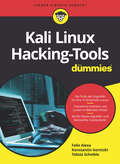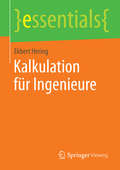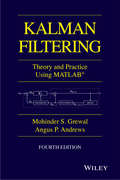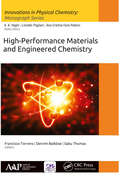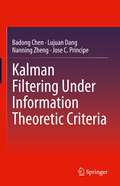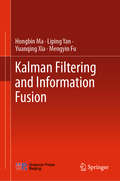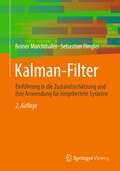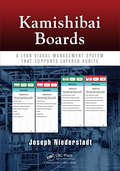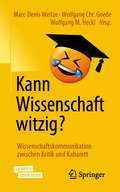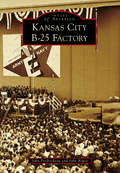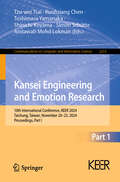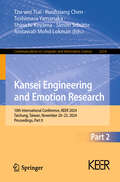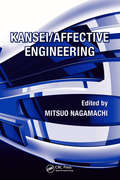- Table View
- List View
Ka-boom!: The Science of Extremes
by David DarlingWhat&’s the brightest light on Earth? The coldest corner of the universe? The blackest material ever made? The most poisonous substance in nature? &‘You will learn something new in every chapter, on every page and probably in every paragraph. Hugely entertaining.&’ Kit Yates, author of The Maths of Life and Death Ka-boom! probes extremes of size and speed, depth and density, and reveals the stickiest, sweetest, smelliest and nastiest substances known to science. In an unabashed celebration of the exceptional, David Darling takes an enlightening journey through the universe&’s weirdest and most wonderful extremes. Travel to far-flung galaxies in pursuit of habitable planets and extra-terrestrial life. Journey to the rainforests of South America and discover the top-speed of the notoriously sluggish sloth. Find out how Earth&’s hardiest creatures – tardigrades or &‘water bears&’ – ended up living on the moon. And meet the scientists and engineers using these quirks of nature to design faster computers, produce greener energy and revolutionise space travel.
Kahoot! Quiz Time Space: Test Yourself Challenge Your Friends (Kahoot! Quiz Time)
by DKMore than 250 trivia questions for curious minds!What is the nearest neighbor to Earth? Do astronauts wear heated gloves? What is the force that pushes a rocket called? Find out in this quiz book, packed with questions and facts about space. Challenge yourself, your family, and friends with awesome questions based on the award-winning online Kahoot! games. Answer the questions, keep score, and declare the winner. Scan the QR codes throughout the book to find more cool quizzes on the same topics within Kahoot! and test your knowledge further. Go for gold and make learning awesome!
Kaizen Assembly: Designing, Constructing, and Managing a Lean Assembly Line
by Chris A. OrtizIt is easy to learn the philosophy and the concepts of kaizen. It is quite another challenge to translate the philosophy into action. While most books expound on the underlying principles and theory, Kaizen Assembly: Designing, Constructing, and Managing a Lean Assembly Line takes you step-by-step through an actual kaizen event. This approach demon
Kalahari
by Jessica KhouryDeep in the Kalahari Desert, a Corpus lab protects a dangerous secret...But what happens when that secret takes on a life of its own? When an educational safari goes wrong, five teens find themselves stranded in the Kalahari Desert without a guide. It's up to Sarah, the daughter of zoologists, to keep them alive and lead them to safety, calling on survival know-how from years of growing up in remote and exotic locales. Battling dehydration, starvation and the pangs of first love, she does her best to hold it together, even as their circumstances grow increasingly desperate. But soon a terrifying encounter makes Sarah question everything she's ever known about the natural world. A silver lion, as though made of mercury, makes a vicious, unprovoked attack on the group. After a narrow escape, they uncover the chilling truth behind the lion's silver sheen: a highly contagious and deadly virus that threatens to ravage the entire area--and eliminate life as they know it. In this breathtaking new novel by the acclaimed author of Origin and Vitro, Sarah and the others must not only outrun the virus, but its creators, who will stop at nothing to wipe every trace of it.
Kali Linux Hacking-Tools für Dummies (Für Dummies)
by Felix Alexa Konstantin Goretzki Tobias ScheibleSie möchten testen, wie sicher Ihr IT-System ist? Dann hilft Ihnen dieses Buch! Es zeigt Ihnen Schritt für Schritt, wie Sie Ihre Systeme mit Kali Linux auf Herz und Nieren prüfen. Sie lernen, wie Passwörter geknackt werden, wie Sie Schwachstellen von Websites finden, die Konfigurationen von Webservern überprüfen und vieles mehr. Außerdem führen die Autoren Sie in Wireless Attacks, Sniffing, Spoofing und IT-Forensik-Analysen ein. Endlose Theorie? Fehlanzeige! Unter Anleitung ausgewiesener IT-Security-Experten lernen Sie aus der Sicht von Hackern zu denken und Ihre IT-Infrastruktur entsprechend zu sichern.
Kali's Song
by Jeanette WinterRenowned picture book author and illustrator Jeanette Winter brings us the enchanting story of a boy named Kali who lived thousands and thousands of years ago. Kali must learn to hunt, like the rest of the men in his tribe. But when Kali plucks the string on his bow, he forgets about shooting arrows, and makes music long into the night. Even the stars come close to listen. This lovely story, celebrating the uniqueness in all of us, the beauty of the natural world, and showing the power of music and art over violence, will be cherished by children everywhere.From the Hardcover edition.
Kalkulation für Ingenieure (essentials)
by Ekbert HeringDie Kalkulation errechnet Preise und Preisuntergrenzen für Produkte und Dienstleistungen. Sie liefert auch wertvolle Informationen für die Wirtschaftlichkeit, der Kostensenkung sowie der Erhöhung der Produktivität in allen Funktionen des Herstellungsprozesses. Behandelt werden die Methoden der Zuschlagskalkulation, die Berechnung der Maschinenstundensätze in der Fertigung sowie die Kalkulation mit Deckungsbeiträgen, mit Prozesskosten und die Kalkulation im Handel. Die klaren Strukturierungen ermöglichen dem Leser, seine Kalkulationsanforderungen in der Praxis sofort erfüllen zu können.
Kalkulation von Baupreisen und Vergabe von Bauleistungen: Ausschreibung, Angebotsbearbeitung, Vergabe und Abrechnung (erfolgreich studieren)
by Peter VogtIm Fokus dieses Lehrbuchs steht zunächst die Pflicht des Bauherrn, Bauleistungen so umfangreich wie nötig zu beschreiben. Diese wichtige Vorarbeit versetzt potenzielle Bieter in die Lage, angemessene Baupreise zu kalkulieren. Damit kommt der Bauherr seinem Ziel, möglichst viele Angebote zu erhalten, ein Stück näher. Das Buch vermittelt anhand von acht Kapiteln, wie die Prozesskette von der Ausschreibung über die Kalkulation bis zur Vertragsgestaltung typischerweise abläuft und welche Verantwortlichkeiten und Risiken sich daraus für die beteiligten Partner ergeben können. Insbesondere der für öffentliche Aufträge streng formale und nach VOB/A geregelte Ablauf wird um praxisnahe Fallbeispiele ergänzt. Zahlreiche Aufgaben mit Lösungen runden das Werk ab. Der Aufbau dieses kompakten Lehrbuchs orientiert sich an der besonderen Didaktik der Reihe "erfolgreich studieren".
Kalman Filtering
by Mohinder S. Grewal Angus P. AndrewsThis book provides readers with a solid introduction to the theoretical and practical aspects of Kalman filtering. It has been updated with the latest developments in the implementation and application of Kalman filtering, including adaptations for nonlinear filtering, more robust smoothing methods, and developing applications in navigation. All software is provided in MATLAB, giving readers the opportunity to discover how the Kalman filter works in action and to consider the practical arithmetic needed to preserve the accuracy of results.Note: CD-ROM/DVD and other supplementary materials are not included as part of eBook file.An Instructor's Manual presenting detailed solutions to all the problems in the book is available from the Wiley editorial department -- to obtain the manual, send an email to ialine@wiley.com.
Kalman Filtering
by Mohinder S. GrewalThe fourth edition of a successful textbook and professional reference on Kalman Filtering - fully updated, revised, and expanded* New sections on the attributes of probability distributions in Kalman filtering; the new sigmaRho filter implementation; and the treatment of nonlinear approximations to Kalman filtering * Features expanded coverage of applications in navigation, derivations and implementations for satellite and inertial navigation error models, and new examples of sensor integration* Includes a companion website with a matrix refresher, problem solutions, and MATLAB® files
Kalman Filtering Techniques for Radar Tracking
by K.V. RamachandraA review of effective radar tracking filter methods and their associated digital filtering algorithms. It examines newly developed systems for eliminating the real-time execution of complete recursive Kalman filtering matrix equations that reduce tracking and update time. It also focuses on the role of tracking filters in operations of radar data processors for satellites, missiles, aircraft, ships, submarines and RPVs.
Kalman Filtering Under Information Theoretic Criteria
by Jose C. Principe Nanning Zheng Badong Chen Lujuan DangThis book provides several efficient Kalman filters (linear or nonlinear) under information theoretic criteria. They achieve excellent performance in complicated non-Gaussian noises with low computation complexity and have great practical application potential. The book combines all these perspectives and results in a single resource for students and practitioners in relevant application fields. Each chapter starts with a brief review of fundamentals, presents the material focused on the most important properties and evaluates comparatively the models discussing free parameters and their effect on the results. Proofs are provided at the end of each chapter. The book is geared to senior undergraduates with a basic understanding of linear algebra, signal processing and statistics, as well as graduate students or practitioners with experience in Kalman filtering.
Kalman Filtering and Information Fusion
by Yuanqing Xia Hongbin Ma Mengyin Fu Liping YanThis book addresses a key technology for digital information processing: Kalman filtering, which is generally considered to be one of the greatest discoveries of the 20th century. It introduces readers to issues concerning various uncertainties in a single plant, and to corresponding solutions based on adaptive estimation. Further, it discusses in detail the issues that arise when Kalman filtering technology is applied in multi-sensor systems and/or multi-agent systems, especially when various sensors are used in systems like intelligent robots, autonomous cars, smart homes, smart buildings, etc., requiring multi-sensor information fusion techniques. Furthermore, when multiple agents (subsystems) interact with one another, it produces coupling uncertainties, a challenging issue that is addressed here with the aid of novel decentralized adaptive filtering techniques.Overall, the book’s goal is to provide readers with a comprehensive investigation into the challenging problem of making Kalman filtering work well in the presence of various uncertainties and/or for multiple sensors/components. State-of-art techniques are introduced, together with a wealth of novel findings. As such, it can be a good reference book for researchers whose work involves filtering and applications; yet it can also serve as a postgraduate textbook for students in mathematics, engineering, automation, and related fields.To read this book, only a basic grasp of linear algebra and probability theory is needed, though experience with least squares, navigation, robotics, etc. would definitely be a plus.
Kalman-Filter: Einführung in die Zustandsschätzung und ihre Anwendung für eingebettete Systeme
by Reiner Marchthaler Sebastian DinglerDieses Lehrbuch befasst sich leicht verständlich mit der Theorie der Kalman-Filterung. Die Autoren geben damit eine Einführung in Kalman-Filter und deren Anwendung für eingebettete Systeme. Zusätzlich wird anhand konkreter Praxisbeispiele der Kalman-Filterentwurf demonstriert – Teilschritte werden im Buch ausführlich erläutert.Kalman-Filter sind die erste Wahl, um Störsignale auf den Sensorsignalen zu eliminieren. Dies ist von besonderer Bedeutung, da viele technische Systeme ihre prozessrelevanten Informationen über Sensoren gewinnen. Jeder Messwert eines Sensors weißt jedoch aufgrund verschiedener Ursachen einen Messfehler auf. Würde ein System nur auf Basis dieser ungenauen Sensorinformationen arbeiten, so wären viele Anwendungen, wie zum Beispiel ein Navigationssystem oder autonome arbeitende Systeme, nicht möglich.Das Buch ist geeignet für interessierte Bachelor- und Master-Studierende der Fachrichtungen Informatik, Maschinenbau, Elektrotechnik undMechatronik. Ebenso ist das Buch eine Hilfe für Ingenieure und Wissenschaftler, die ein Kalman-Filter z. B. für die Datenfusion oder die Schätzung unbekannter Größen in Echtzeitanwendungen einsetzen möchten.
Kamishibai Boards: A Lean Visual Management System That Supports Layered Audits
by Joseph NiederstadtPart of the Toyota Production System, Kamishibai boards are simple and flexible visual controls for performing audits within a manufacturing process. When used properly, they are powerful tools for performing, managing, and auditing tasks of specific duties.Kamishibai Boards: A Lean Visual Management System That Supports Layered Audits explains how to use this visual management system to identify normal conditions versus abnormal conditions in your organization. Filled with easy-to-follow instructions that require minimal training, it outlines a layered audit system for sustaining continuous improvement that can be applied to any organization in any industry.The book includes downloadable resources with master forms you can use to create your own daily, weekly, or monthly Kamishibai cards for any subject. The downloadable resources also include electronic copies of all examples in the book.Helping you focus on resolving abnormal situations, the book supplies the understanding required to make problems, abnormalities, and variations from the standard visible so corrective actions can be made right away—so you can spend more of your valuable time on achieving sustainable improvement.
Kampus
by James GunnThe college of the future has just one purpose: endless battle. Political organizations urge ruthless combat with an invisible opponent and each student is challenged to be more extreme than the rest. One man finds his fame by kidnapping and killing a professor. Instantly he is immersed into the world of grease-guns and grenades, where the anarchy is suspiciously formulated. The professors have forgotten their pursuit of knowledge, midnight groping at the point has turned into isolated sex with keyboards and the only goal is to compete in deadly political games. By becoming a shining example of academic excellence, Tom Gavin has tapped into the secrets inside the private chambers of the university. He finds it is either play the game or die beneath the latest revolutionary fire.
Kanban Change Leadership
by Siegfried Kaltenecker Klaus LeopoldExplains how and why Kanban offers a new approach to change in 21st Century businesses This book provides an understanding of what is necessary to properly understand change management with Kanban as well as how to apply it optimally in the workplace. The book emphasizes critical aspects, several traps which users repeatedly fall into, and presents some practical guidelines for Kanban change management to help avoid these traps. The authors have organized the book into three sections. The first section focuses on the foundations of Kanban, establishing the technical basis of Kanban and indicating the mechanisms required to enact change. In the second section, the authors explain the context of Kanban change management--the options for change, how they can be set in motion, and their consequences for a business. The third section takes the topics from the previous sections and relates them to the social system of business--the goal is to guide readers in the process of building a culture of continuousimprovement by reviewing real case studies and seeing how Kanban is applied in various situations. Kanban Change Leadership: Explains how to implement sustainable system-wide changes using Kanban principles Addresses the principles and core practices of Kanban including visualization, WIP limits, classes of service, operation and coordination, metrics, and improvement Describes implementation, preparation, assessment, training, feedback, commissioning, and operation processes in order to create a culture of continuous improvement Kanban Change Leadership is an educational and comprehensive text for: software and systems engineers; IT project managers; commercial and industrial executives and managers; as well as anyone interested in Kanban.
Kanban for the Supply Chain: Fundamental Practices for Manufacturing Management, Second Edition
by Stephen CimorelliFollowing in the footsteps of its popular predecessor, the second edition of this workbook explains how to apply kanban replenishment systems to improve material flow. Kanban for the Supply Chain: Fundamental Practices for Manufacturing Management, Second Edition provides readers with a detailed roadmap for achieving a successful and sustainable kanban implementation.Detailing the steps required for each stage of the manufacturing and supply chain management process, this updated edition focuses on creating an environment for success. It addresses internal mechanisms, including leveling production schedules, as well as external elements, such as conducting a thorough analysis of customer demand. Numerous techniques are presented for setting up kanban that consider a wide array of material types, dimensions, and storage media. This edition presents a wealth of new tools and techniques useful across the broad spectrum of manufacturing environments, including: A statistical data cleansing technique to remove questionable or irrelevant data from kanban calculations Correlation analysis based on simple Excel techniques to guide the decisions around which part numbers "qualify" for kanban An alternative "stair-step analysis" approach for those who are unable to generate correlation data and prefer to use more readily available monthly demand history An approach to analyze supplier performance data vs. lead time and lot size expectations, with risk mitigation strategies for poor performing suppliers This book is for those who are ready to stop thinking about a conversion from materials requirements planning push techniques to kanban pull techniques and want to make it happen now. Stephen Cimorelli provides actionable advice for installing fundamental kanban concepts that can immediately help you increase manufacturing productivity and profitability. The book includes team-based exercises that reinforce key principles as well as a CD with helpful outlines, charts, figures, and diagrams.
Kandarpa Handbook of Interventional Radiologic Procedures
by Robert Lewandowski Lindsay Machan Parag J. Patel Krishna KandarpaFocusing on time-tested protocols, tailored imaging and current procedural equipment, this popular, practical handbook by Drs. Krishna Kandarpa, Lindsay Machan, Robert Lewandowski, and Parag J. Patel features extensive updates to keep you current with rapid growth in the field. Now in brilliant full color throughout, Kandarpa Handbook of Interventional Radiologic Procedures, 6th Edition, is a convenient, easy-access guide to all current radiologic procedures. It’s an ideal resource not only for practicing interventional and general radiologists, but also for fellows and residents in training, IR nurses, and special procedure technologists.
Kann Wissenschaft witzig?: Wissenschaftskommunikation zwischen Kritik und Kabarett
by Marc-Denis Weitze Wolfgang M. Heckl Wolfgang Chr. Goede"Kann Wissenschaft witzig?“ nimmt ein ebenso innovatives wie zukunftsträchtiges Element moderner Wissenschaftskommunikation unter die Lupe: Die Komik!Leserinnen und Leser werden durch anschaulich gehaltene akademische Theorie sowie spannende Hands-on- und Best Practice-Beispiele renommierter Praktiker und Kabarettisten geführt:· Was haben Schafskäse und Autoreifen gemeinsam?· Kann Lachen Mauern einreißen lassen?· Wie funktioniert „Die Anstalt“· Wie schafft Zauberkunst Wissen?· Gibt es Humor im Museum?· Kommt ein Dalmatiner an die Kasse· Drei Schritte zum Humor· Serviervorschlag für den Heiligen Geist· Diktatur der Dummheit· Und viel mehr!Das ist aber nicht alles nur lustig. Komik kann auch Kritik etwas von ihrer beißenden Schärfe nehmen, die Kritik für die Adressaten verdaulich, ja sogar schmackhaft machen.„Kann Wissenschaft witzig?“ navigiert zwischen Kritik und Kabarett und setzt sich mit Komik in verschiedenen Spielarten aus unterschiedlichen Perspektiven auseinander. 22 Beiträge zeigen, wie sich die Ergebnisse von Wissenschaft, Forschung, Technologie auf neuen Wegen in die breite Öffentlichkeit tragen lassen. Sie demonstrieren insbesondere auch, wie Humor sich als kritisch-fragende Kraft einsetzen lässt – wertvoll für sämtliche Kommunikationsarten und hilfreich, damit sie in Zukunft gewitzter daherkommen.
Kansas City B-25 Factory (Images of Aviation)
by John Fredrickson John RoperAn industrial miracle took place at the Fairfax Airport, on the shores of the Missouri River, between 1941 and 1945. A massive factory was quickly built and a large modification center was soon added. At its peak, over 24,000 greater Kansas City-area residents were employed by North American Aviation, Inc. Their goal was to build as many twin-engine B-25 Mitchell medium bombers for wartime service as possible. Their success was the construction of an unprecedented 6,608 aircraft. The B-25 Mitchell served with distinction in every theater of World War II, and significant numbers of them were provided to Allied nations. Many B-25s have been preserved, and some of them remain airworthy today. They can be seen on static display or in flight at air shows all across America.
Kansei Engineering and Emotion Research: 10th International Conference, KEER 2024, Taichung, Taiwan, November 20–23, 2024, Proceedings, Part I (Communications in Computer and Information Science #2313)
by Anitawati Mohd Lokman Toshimasa Yamanaka Kuohsiang Chen Shinichi Koyama Tzu-Wei Tsai Simon SchütteThe two volume set, LNCS 2313 and LNCS 2314, constitutes the proceedings of the 10th International Conference on Kansei Engineering and Emotion Research, KEER 2024, held in Taichung, Taiwan during November 20–23, 2024. The 57 full papers presented in these volumes were carefully reviewed and selected from 154 submissions. These papers have been organized in the following topical sections:- Part I: Emotion Research in Southeast Asia (SEA): Bridging Cultures, Advancing Design; Competencies Required by Different Positions for Innovation; Exploring the Intersection of Kansei Engineering and Affective Computing in Digital Media Design Research; Image and Media in Kansei Design; Innovative Design for Cultural Sustainability. Part II: Kansei Approach to Sustainability Society; Kansei in Senses and Interaction; Kansei Issues in Cross-Cultural Design; Wellbeing/ Experience Quality of Life/ Healthcare.
Kansei Engineering and Emotion Research: 10th International Conference, KEER 2024, Taichung, Taiwan, November 20–23, 2024, Proceedings, Part II (Communications in Computer and Information Science #2314)
by Anitawati Mohd Lokman Toshimasa Yamanaka Kuohsiang Chen Shinichi Koyama Tzu-Wei Tsai Simon SchütteThe two volume set, LNCS 2313 and LNCS 2314, constitutes the proceedings of the 10th International Conference on Kansei Engineering and Emotion Research, KEER 2024, held in Taichung, Taiwan during November 20–23, 2024. The 57 full papers presented in these volumes were carefully reviewed and selected from 154 submissions. These papers have been organized in the following topical sections:- Part I: Emotion Research in Southeast Asia (SEA): Bridging Cultures, Advancing Design; Competencies Required by Different Positions for Innovation; Exploring the Intersection of Kansei Engineering and Affective Computing in Digital Media Design Research; Image and Media in Kansei Design; Innovative Design for Cultural Sustainability. Part II: Kansei Approach to Sustainability Society; Kansei in Senses and Interaction; Kansei Issues in Cross-Cultural Design; Wellbeing/ Experience Quality of Life/ Healthcare.
Kansei Innovation: Practical Design Applications for Product and Service Development (Systems Innovation Book Series)
by Anitawati Mohd Lokman Mitsuo NagamachiDeveloped in the early 70s in Japan, the Kansei Engineering (KE) method gives you the tools to develop profitable and well-received products and services. Written by the founder of KE, MitsuoNagamachi, and co-authored by one of his proteges, Anitawati Mohd Lokman, Kansei Innovation: Practical Design Applications for Product and Service Development
Kansei/Affective Engineering (Systems Innovation Book Series)
by Mitsuo NagamachiA guided tour through the each stages of process, Kansei/Affective Engineering explores how to apply Kansei/Affective Engineering. It describes the psychological survey and psycho-physiological measurement of consumer feelings and the multivariate statistical analysis of this survey data, including rough set models. Since soft computing technology
